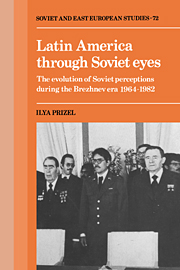 Latin America through Soviet Eyes
Latin America through Soviet Eyes Book contents
- Frontmatter
- Contents
- Preface
- Acknowledgments
- Introduction
- Part I Soviet perceptions of Latin America's global role
- Introduction
- 1 Soviet perceptions of US–Latin American relations
- 2 Latin America's role in the capitalist division of labor
- 3 Latin America's role in the Third World
- 4 Soviet views on Latin America's regional integration
- 5 Soviet conclusions regarding Latin America's ability to conduct an independent foreign policy
- Part II Soviet perceptions of Latin American social structures
- Part III Soviet–Latin American relations during the Brezhnev era
- Part IV Conclusion: the emerging Soviet perception of Latin America and the future of Soviet policy toward the hemisphere
- Conclusions
- Epilogue – Latin America: the Long March
- Notes
- Bibliography
- Index
- Frontmatter
- Contents
- Preface
- Acknowledgments
- Introduction
- Part I Soviet perceptions of Latin America's global role
- Introduction
- 1 Soviet perceptions of US–Latin American relations
- 2 Latin America's role in the capitalist division of labor
- 3 Latin America's role in the Third World
- 4 Soviet views on Latin America's regional integration
- 5 Soviet conclusions regarding Latin America's ability to conduct an independent foreign policy
- Part II Soviet perceptions of Latin American social structures
- Part III Soviet–Latin American relations during the Brezhnev era
- Part IV Conclusion: the emerging Soviet perception of Latin America and the future of Soviet policy toward the hemisphere
- Conclusions
- Epilogue – Latin America: the Long March
- Notes
- Bibliography
- Index
Summary
Although most of Latin America attained formal independence in the early nineteenth century, and in fact most of the region's states predate many European states, Latin America played only a peripheral role in the world arena. The center of the arena was Europe, geographically distant from Latin America. When British policy severely limited European influence in the Americas (and enabled President Monroe to develop the so-called Monroe Doctrine), Latin America's global political role became further marginalized. After the end of World War II, as Britain, Germany, and France withdrew from the Latin American scene, the area fell almost entirely into the US sphere of influence.
Given the preponderant US domination of both Latin America and the OAS, it is hardly surprising that the USSR retained a contemptuous attitude toward the hemisphere. For years the prevailing Soviet perception had been that Latin America, although nominally politically independent, in reality was little more than an adjunct to various colonial powers. Stalin and Molotov often described the region's states as “US satellites” or “pseudo-colonies of the US.”
This attitude continued well into the Brezhnev era, unmodified until the late 1960s. Latin America was not included in changing Soviet perceptions of the Third World after Stalin's death, when Soviet analysts conceded that newly independent states governed by the bourgeoisie were not necessarily stooges of imperialism. Khrushchev recognized that such states as Egypt and India were indeed capable of severing their ties with their imperialist patrons.
- Type
- Chapter
- Information
- Latin America through Soviet EyesThe Evolution of Soviet Perceptions during the Brezhnev Era 1964–1982, pp. 7 - 8Publisher: Cambridge University PressPrint publication year: 1990
